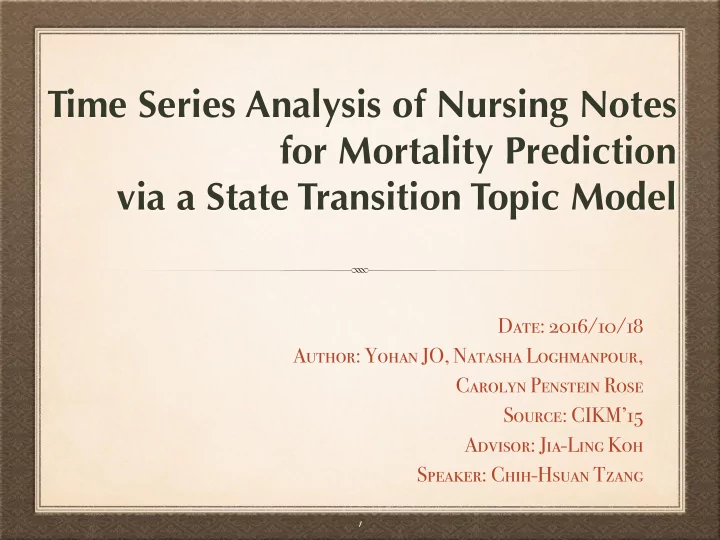

Time Series Analysis of Nursing Notes for Mortality Prediction via a State Transition Topic Model Date: 2016/10/18 Author: Yohan JO, Natasha Loghmanpour, Carolyn Penstein Rose Source: CIKM’15 Advisor: Jia-Ling Koh Speaker: Chih-Hsuan Tzang 1
Introduction Method Experiment Conclusion 2
Introduction Method Experiment Conclusion 3
Introduction • Family support • Mental fitness • Facial expressions • Nurses’ intuitions & plans 4
Introduction Motivation: • Predicting a patient’s risk of mortality and taking appropriate action are important activities in intensive care units ( ICUs ) . • Nursing notes have the potential to uncover hidden clues about a patient’s health and mental state as they change over time, such as the factors of family support and mental fitness 5
Introduction Goal: • Proposes and evaluates a model to uncover the temporal dynamics of underlying patient states from nursing notes. • Evaluates the e ff ectiveness of the identified temporal dynamics for improving mortality prediction. • O ff ers qualitative insight into di ff erent types of textual features regarding their roles in mortality prediction. 6
Introduction ( STTM ) 7
Introduction Method Experiment Conclusion 8
Method 9
Method • W e perform predictions in the short - term ( one day and one week ) and in the long - term ( one month, six months, and one year ) . • Since some notes are too short or focus only on a single topic, all nursing notes in the same time point are merged into one document for analysis so that the merged document can reflect the overall topics at that time point. 10
Method 11
Method State T ransition Topic Model ( STTM ) : 12
Method Latent Dirichlet Allocation ( LDA ) : Example: 1. I like to eat broccoli and bananas. 2. I ate a banana and spinach smoothie for breakfast. 3. Chinchillas and kittens are cute. 4. My sister adopted a kitten yesterday. 5. Look at this cute hamster munching on a piece of broccoli. 13
Method Latent Dirichlet Allocation ( LDA ) : 1. I like to eat broccoli and bananas . 2. I ate a banana and spinach smoothie for breakfast . 3. Chinchillas and kittens are cute . 4. My sister adopted a kitten yesterday. 5. Look at this cute hamster munching on a piece of broccoli . • Sentences 1 and 2: 100 % Topic A • Sentences 3 and 4: 100 % Topic B • Sentences 5: 60 % Topic A, 40 % Topic B • Topic A: 30 % broccoli, 15 % bananas, 10 % breakfast, 10 % munching • Topic B: 20 % chinchillas, 20 % kittens, 20 % cute, 15 % hamster,… 14
Method Hidden Markov Model ( HMM ) : 15
Method STTM: 16
Method 17
Method N - grams: • For each patient, unigrams and bigrams are extracted from nursing notes. • use 200 and 100 top n - grams for the mortality group and the survival group. • the mortality group, is much smaller than the survival group, requires more n - grams for high recall. • Pointwise Mutual Information 18
Method Standard Topics: • Topic distributions learned by LDA are used. • Topic distributions are extracted from individual nursing notes ( not merged notes ) . • The extracted topic distributions are averaged and aggregated into one feature vector. • The dimension is equal to the number of topics. 19
Method State - aware Topics: • Document - wise topic distributions learned by STTM are used • STTM estimates one state per time point • The topic distributions of all documents are aggregated into one feature vector as for standard topics. 20
Method State T ransitions: • a sequence of states is estimated by STTM. • only the latest four time points ( i.e., two days ) are considered ( S + S 2 ) • longer sequences tend to include more states and have lower element values. 21
Method 22
Method cost - sensitive SVMs: 23
Introduction Method Experiment Conclusion 24
Experiment • Clinical data of ICU patients collected between 2001 and 2008 25
Experiment Task 1. State T ransitions Learned From Nursing Notes: 26
Experiment Task 2. Mortality Prediction with Temporal Information: 27
Experiment Task 2. Mortality Prediction with Temporal Information: 28
Experiment Task 2. Mortality Prediction with Temporal Information: 29
Experiment Task 3. Mortality Prediction by Individual features: 30
Experiment Enrichment: 31
Introduction Method Experiment Conclusion 32
Conclusion • The learned temporal informations beneficial for long- term mortality prediction, but not much in short-term prediction. • STTM can be applied to any data stream. 33
Recommend
More recommend